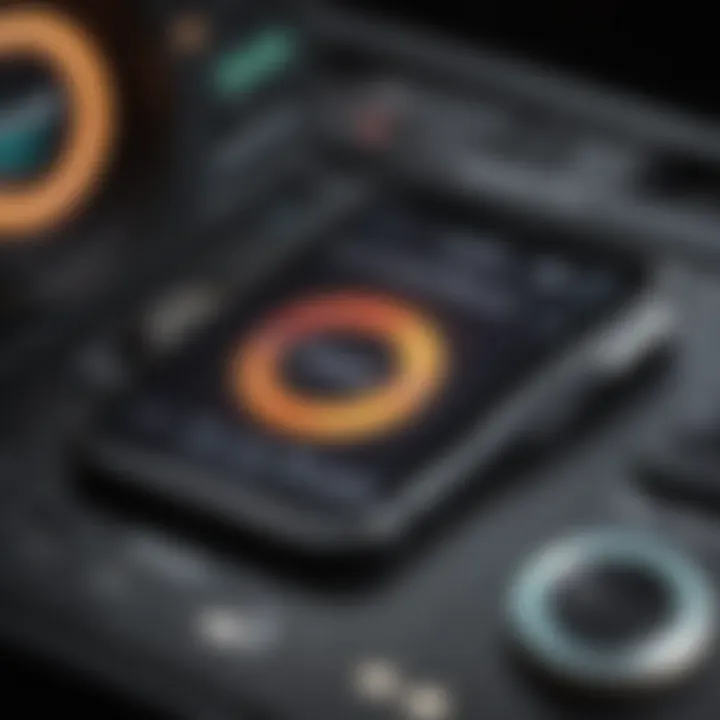Ultimate Guide: How to Get New Ringtones on Your iPhone and Personalize Your Device


Product Overview
When it comes to customizing your i Phone, setting unique ringtones can add a personal touch and enhance the overall user experience. This comprehensive guide will navigate you through the process of acquiring and implementing new ringtones for your device. The article delves into various methods and sources to obtain tailored ringtones, aiming to elevate your iPhone's individuality and functionality.
Performance and User Experience
The performance of your i Phone in relation to ringtones focuses on the device's ability to seamlessly integrate and play these audio files. The user interface plays a crucial role in managing and setting up the ringtones, ensuring a smooth and intuitive experience. User feedback will be explored to offer insights into the practicality and convenience of using custom ringtones on iPhones.
Comparison with Previous Models or Competitors
In comparison to earlier i Phone models and competitor devices, the process of setting new ringtones on the latest iPhone showcases any advancements and improvements. Analyzing how this feature differs from other similar products highlights Apple's unique value proposition in catering to user preferences for customization.
Tips and Tricks
To optimize your experience with new ringtones on your i Phone, this section will provide detailed how-to guides and tutorials. Discover hidden features and functionalities related to setting and managing ringtones, along with troubleshooting tips for common issues that may arise along the way.
Latest Updates and News
Stay informed about recent software updates introducing new features relevant to ringtones on i Phones. Delve into industry news, rumors about upcoming Apple products, and catch up on key events and announcements shaping the tech landscape related to personalized audio settings for your device.
Exploring Ringtone Options
In the quest to personalize your i Phone, exploring ringtone options holds substantial value. It is a significant aspect of device customization, offering a unique way to tailor your device's alerts to your preferences. By delving into different ringtone choices, users can distinguish their phones from others, adding a touch of individuality to their mobile experience.
Check Built-in Ringtones
Navigate to Settings
When it comes to selecting a ringtone for your i Phone, navigating to Settings is the initial step. This feature allows users to access a range of built-in tones without the need for external downloads. The simplicity and ease of use of this method make it a popular choice among those looking for a quick and hassle-free way to change their ringtones. By exploring the Settings menu, users can find a variety of pre-installed tones to suit their preferences.
Select Sounds & Haptics
Selecting Sounds & Haptics within the Settings menu provides users with further customization options. This feature enables users to fine-tune various sound settings on their devices, including ringtones, vibrations, and alerts. The ability to adjust these settings individually offers a high level of personalization, allowing users to create a tailored experience based on their preferences and needs.


Choose Ringtone
Choosing a specific ringtone from the options available in the Sounds & Haptics section allows users to set a unique tone for different kinds of notifications. This versatility enables users to associate specific tones with particular contacts or apps, making it easier to identify who or what is trying to get their attention. The ability to customize ringtones plays a crucial role in optimizing the user experience and enhancing device functionality.
Creating Custom Ringtones
Creating custom ringtones adds a personal touch to your i Phone, reflecting your unique style and preferences. Stand out from the generic tones and create something distinctive that resonates with you. Custom ringtones allow you to express your individuality and set your device apart from others. When considering creating custom ringtones, think about the type of music or sound that represents you or that you find appealing. It's a fun and creative process that enhances the overall experience of owning an iPhone.
Using GarageBand
Open GarageBand App
Opening the Garage Band app on your iPhone initiates the process of crafting your custom ringtone. This feature-rich application offers a range of tools and functionalities for creating original sounds. The user-friendly interface of GarageBand simplifies the music-making experience, making it accessible to both beginners and seasoned musicians. Whether you're a music enthusiast or a casual user, GarageBand's versatility caters to a wide audience. Its seamless integration with iOS devices makes it a popular choice for custom ringtone creation.
Create New Project
Creating a new project in Garage Band allows you to start composing your custom ringtone from scratch. This feature enables you to experiment with different sounds, instruments, and arrangements to achieve the desired tone. The customization options within GarageBand empower you to unleash your creativity and produce a ringtone that captures your personality. With diverse editing tools and sound effects at your disposal, crafting a unique ringtone becomes an enjoyable and engaging process.
Export as Ringtone
Exporting your composition as a ringtone in Garage Band finalizes the creative journey. This functionality converts your musical creation into a suitable format for setting as a ringtone on your iPhone. The seamless export process ensures that your custom ringtone maintains its quality and integrity when transferred to your device. GarageBand's export feature streamlines the conversion process, allowing you to enjoy your personalized ringtone effortlessly.
Setting Up New Ringtones
Setting up new ringtones on your i Phone is a crucial aspect of personalization and customization for your device. By assigning custom ringtones to different contacts, you can easily identify who is calling without even looking at your phone. It adds a personalized touch to your iPhone experience, making it not only functional but also uniquely yours. Ensuring you have the right ringtones set up for different contacts can improve your efficiency in communication and enhance the overall user experience of using your iPhone.
Assigning Ringtones to Contacts
Open Contacts App
Opening the Contacts app on your i Phone allows you to manage and customize individual ringtones for each contact. This feature is highly beneficial as it enables you to associate specific tones with particular people, making it easier to identify callers even when your phone is not in hand. The ability to assign custom ringtones to contacts is a popular choice among users looking for a more personalized interaction with their device. The Contacts app streamlines the process of assigning ringtones, ensuring that you can quickly identify important calls.
Edit Contact


Editing individual contacts within the Contacts app permits you to personalize their ringtones according to your preference. This function is a beneficial tool for customizing your i Phone experience, as it allows you to associate unique tones with specific contacts. The Edit Contact feature's key characteristic is its user-friendly interface, making it simple for users to navigate and select the desired ringtones for each contact. While the Edit Contact feature offers great flexibility in customizing ringtones, it might require some time initially to set up personalized tones for each contact.
Select Custom Ringtone
Selecting a custom ringtone for a contact is a key step in personalizing your calling experience. This feature enables you to set distinct tones for different contacts, providing a quick and easy way to identify callers based on the assigned ringtone. The unique aspect of selecting custom ringtones is the ability to tailor your device's alert system to suit your preferences. While this customization adds a personal touch to your i Phone, managing a large number of contacts with individual ringtones can become tedious over time. However, the advantages of easily identifying callers outweigh the potential inconvenience of setting up custom ringtones for each contact.
Setting Default Ringtone
Setting the default ringtone on your i Phone is essential for ensuring a consistent and recognizable alert for incoming calls. Navigating to the Settings section of your device allows you to choose the default tone that will play for any unidentified caller. Establishing a default ringtone helps maintain a unified sound experience, particularly if custom ringtones are not assigned to specific contacts. The Go to Settings feature provides a straightforward method for adjusting the default ringtone, offering users a quick way to customize their overall calling experience.
Choose Sounds & Haptics
Choosing Sounds & Haptics within the Settings menu grants you access to various audio and vibration settings on your i Phone. This feature's key characteristic lies in its ability to control the sound and vibration feedback of your device, allowing for personalized alerts. Sounds & Haptics are a popular choice for users seeking to customize their iPhone's audio and tactile responses, enhancing the overall user experience through personalized settings. While this feature offers great flexibility in sound and vibration adjustments, finding the perfect settings to suit individual preferences may require some trial and error.
Select Default Ringtone
Selecting the default ringtone ensures that all incoming calls have a consistent tone, making it easier to recognize and differentiate them from other notifications. This feature is beneficial for users who prefer a uniform alert for all incoming calls, maintaining a standardized sound experience across the device. The unique characteristic of selecting the default ringtone lies in its ability to provide a default sound option that suits the user's preferences. While the default ringtone simplifies the alert system, users may need to periodically change it to avoid monotony or enhance the device's overall customization.
Creating Vibration Patterns
Creating custom vibration patterns for your contacts adds a tactile dimension to your i Phone's alert system, further personalizing your communication experience. Accessing the Ringtone Vibration Settings allows you to set unique vibrations for different contacts, providing a silent yet distinct way to identify callers. Assigning patterns to contacts through customized vibrations offers users a subtle yet effective method of call recognition. The unique feature of customizing vibrations is the ability to establish personalized tactile alerts, catering to individual preferences and enhancing the overall user experience.
Assign Patterns to Contacts
Assigning custom vibration patterns to contacts allows you to distinguish callers solely based on vibration feedback, ideal for situations where sound alerts are not feasible. This feature contributes to a personalized experience by associating unique patterns with specific contacts, ensuring that you can identify callers discreetly. The key characteristic of assigning patterns to contacts is the non-intrusive yet effective nature of vibration alerts, offering a silent but distinct form of call identification. While customizing vibration patterns requires some initial setup, the benefits of personalized tactile alerts outweigh the minor inconvenience.
Customize Vibrations
Customizing vibrations on your i Phone provides a unique way to differentiate between incoming calls without relying on sound alerts. This feature's significant advantage lies in its discrete and personalized nature, allowing you to recognize callers solely through tactile means. Customized vibrations offer users flexibility in tailoring their alert preferences, catering to individual needs and preferences. While customizing vibrations may require some experimentation to find the ideal patterns, the ability to create personalized alerts enhances the overall communication experience on your iPhone.
Troubleshooting
Troubleshooting plays a crucial role in the context of this article as it addresses common problems that users may encounter when trying to set up new ringtones on their i Phone. By discussing troubleshooting methods, users can proactively resolve issues, ensuring a smooth and hassle-free experience in personalizing their device. This section aims to equip readers with the necessary knowledge and skills to troubleshoot any obstacles they may face while getting new ringtones on their iPhone.


Ringtone Not Showing Up
Restart iPhone
Restarting the i Phone is a fundamental troubleshooting step that can effectively resolve various issues related to ringtones not showing up. When an iPhone undergoes a restart, it refreshes its system processes, often eliminating any software glitches or bugs that may be hindering the visibility of new ringtones. This method is a popular choice for troubleshooting as it is a quick and simple technique that can quickly resolve common problems related to ringtones not appearing as expected. While restarting the iPhone may seem basic, its effectiveness in resolving minor software issues cannot be overlooked, making it an essential step in the troubleshooting process for ringtone visibility.
Check Ringtone Format
Checking the ringtone format is another critical aspect of troubleshooting when new ringtones fail to appear on the i Phone. Incompatible or unsupported ringtone formats can prevent the device from recognizing and displaying the selected tones. By verifying that the ringtone format meets the iPhone's requirements, users can ensure seamless integration and display of custom ringtones. This step helps users identify any format discrepancies and take corrective actions to convert or obtain compatible ringtone formats that are supported by the iPhone, enhancing the chances of successful ringtone display.
Re-sync with iTunes
Re-syncing the i Phone with iTunes can effectively tackle issues where new ringtones do not show up on the device despite being successfully added. By synchronizing the iPhone with iTunes, users can ensure that any changes or additions to the ringtone library are accurately reflected on the device. This troubleshooting step helps in resolving synchronization errors, ensuring that custom ringtones are properly transferred and visible on the iPhone. Re-syncing with iTunes acts as a reliable solution to address discrepancies between the computer's ringtone library and the iPhone, ultimately ensuring a seamless transition of new ringtones onto the device.
Volume or Sound Issues
Adjust Volume Settings
Adjusting volume settings is a vital aspect of troubleshooting sound-related issues on the i Phone. Incorrect volume configurations can lead to issues such as low ringtone volume or sound distortions, impacting the overall user experience. By customizing volume settings to suit individual preferences, users can optimize the sound quality and ensure that custom ringtones play at the desired level. This step empowers users to fine-tune the audio output of their device, addressing any volume irregularities that may arise during the use of personalized ringtones.
Ensure Silent Mode Off
Ensuring that silent mode is turned off is essential when troubleshooting sound problems associated with new ringtones on the i Phone. Silent mode can inadvertently silence incoming calls or notifications, causing users to miss alerts even when custom ringtones have been set. By disabling silent mode, users can guarantee that custom ringtones play audibly, allowing them to differentiate incoming calls or messages effectively. This troubleshooting step prevents sound issues caused by silent mode, ensuring that personalized ringtones function as intended.
Check Speaker Functionality
Checking the functionality of the i Phone's speaker is a key troubleshooting measure when encountering sound-related problems with new ringtones. Malfunctioning speakers can impede the playback of custom tones, leading to muffled audio or no sound output. By verifying the speaker's functionality, users can pinpoint any hardware issues that may be affecting the sound quality of custom ringtones. This step enables users to identify and address speaker problems promptly, ensuring optimal sound performance when using personalized tones on the iPhone.
App Compatibility Problems
Update App Version
Updating the app version is a crucial troubleshooting technique to address compatibility issues between ringtone apps and the i Phone's operating system. Outdated app versions may lack essential enhancements or bug fixes, resulting in functionality issues when setting new ringtones. By updating the ringtone app to the latest version, users can leverage improved features, compatibility upgrades, and bug fixes that enhance app performance on the iPhone. This step aims to ensure seamless app integration and optimal functionality, mitigating potential compatibility problems that may arise when customizing ringtones on the device.
Review App Permissions
Reviewing app permissions is an integral aspect of troubleshooting app compatibility problems on the i Phone. Inadequate app permissions can restrict the app's functionality, preventing it from accessing the necessary resources to set custom ringtones successfully. By reviewing and adjusting app permissions, users can grant the app the required access rights, ensuring smooth operation and integration with the iPhone's firmware. This step empowers users to troubleshoot app compatibility issues effectively, fostering a seamless experience when using ringtone apps to customize tones on their device.
Check iOS Compatibility
Verifying i OS compatibility is essential to troubleshoot issues related to app performance and ringtone customization on the iPhone. Incompatibility between the ringtone app and the iPhone's operating system can lead to errors, crashes, or limited functionality when setting new tones. By ensuring that the app is compatible with the current iOS version, users can preemptively address compatibility issues, guaranteeing a harmonious interaction between the app and the device. This step focuses on optimizing app performance and user experience by resolving potential iOS compatibility problems, facilitating a smooth process of personalizing ringtones on the iPhone.



